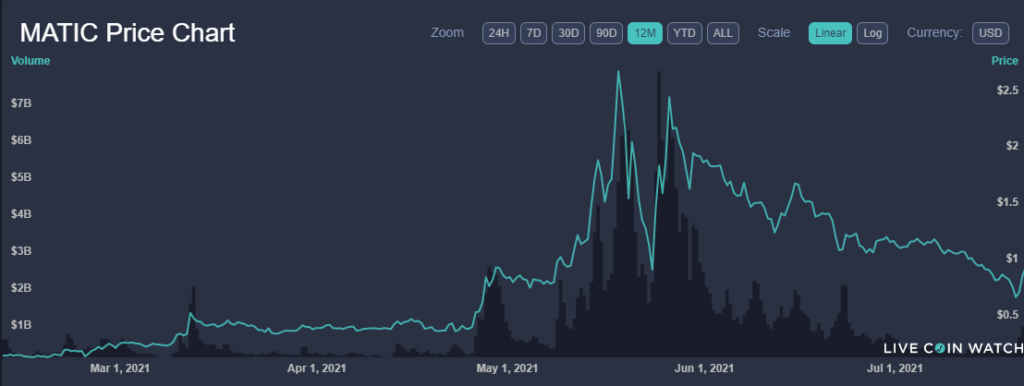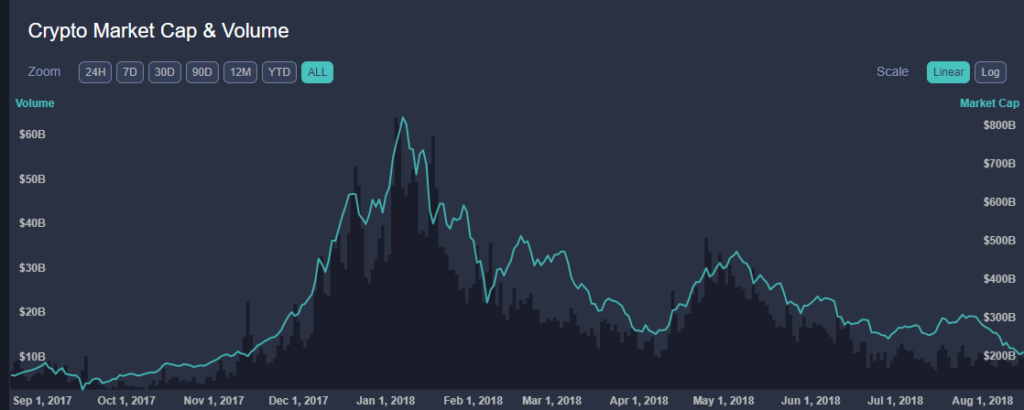If there is one thing nearly everyone involved in the crypto market agrees with, it’s that the market is volatile.
When it moves, it really moves. During the “big run” in 2018, the cryptocurrency market cap went from roughly $150 billion to over $800 billion from October 2017 to January 2018. However, in the months that followed, the market fell sharply to a $100 billion market cap in December of 2018. These kinds of moves can be great if you are on the correct side, but very difficult if you are not.

With investors and traders typically using cryptocurrency for short term gains, long time durations without explosive profits become problematic. This caused many people to exit the market, with many of them taking considerable losses after having bought in the big run up due to what is commonly referred to now as “FOMO”, or Fear of Missing Out.
For those that stayed in the market and used the tried-and-true strategy of “Dollar Cost Averaging” (DCA), they were able to build substantial positions during a very quiet time in the cryptocurrency markets and profit when the market took off from $179 billion in May of 2019 to $2.2 billion in May of 2021. For those looking for quick math, the entire market increased 1200% over that time.

During this most recent bull run, many smaller coins swung rapidly and many people became rich, at least on paper. Hopefully most people that saw huge gains were able to take some profit. This is the part of what makes cryptocurrency markets unique. In the stock market, the vast majority of us will never turn $100 into anything more than a few hundred bucks unless they hit on a penny stock or some crazy once in a lifetime play. In cryptocurrency, we have the opportunity to build potentially life-altering wealth with a smaller financial commitment. While we at CoinBusters don’t look favorably on DOGE, a lot of people who put $100 into it very early on saw that turn into incredible profits. MATIC was only a few cents as recently as last year (2020) and soared past $2.50 during the big run in May of 2021.
Much like stock investing, the safest way to invest in cryptocurrency is “time in market” not “timing the market”. Research a project, find something you really think is going to work, and just set it and forget it. We’ll discuss balancing risk and how we build portfolios in other blogs, videos, podcasts, etc. but by being strategic and investing in projects you believe will add value, you can ride the waves of market volatility. The cryptocurrency market will likely ebb and flow like it has in the past, with periods of explosive growth that you can position yourself to take advantage of.
To fight market volatility, we need two things: Stablecoins and Dollar Cost Averaging. If you accept that some days the market will be up and down 10+% and that periods of profit-taking can quickly take 50% off of the value of smaller market cap tokens, you could see incredible gains in the future as the cryptocurrency market continues to adapt and mature.
Dollar cost averaging is a way to mitigate downside risk by not going “all-in” immediately, but instead buying in pieces, especially when markets are selling off. There are three primary strategies you can employ to dollar cost average:
- Buy a certain amount of tokens on a consistent time frame regardless of price, sort of like a 401(k) contribution from every paycheck. One simple example would be to take $100 per week and buy BTC. You’re not letting the current dollar value concern you, but instead building a position with a steady contribution.
- “Buy the dip” – buy when an asset you’ve invested in drops a certain amount or percent. This lowers your average cost, and allows you to profit more from market run-ups since you’ll have more tokens also. When you buy $100 worth of a token that is worth $1.00, you’ll have 100 tokens. If that token drops 50% to $0.50, that same $100 would have been able to buy 200 tokens. Buying on the way down is one of the most common strategies successful investors use in any market – stocks, crypto, etc. When we DCA, we make sure not to invest everything immediately, but steadily buy according to a process or plan.
- We can also take a hybrid of these two strategies by consistently depositing a contribution into stablecoins for easy access (and great interest – some offer 4% or more), and drawing from that reserve to buy a token when it drops in value. This is a good strategy for people who deposit funds at regular intervals (paychecks, weekly, etc.) and are willing to pay closer attention to the markets to identify good days to buy on a drop. It’s important to take advantage of lower prices, but keeping some cash ready if prices drop more.
Stablecoins are considered a sort of safe haven from the volatility associated with cryptocurrencies. They are pegged to values of USD, EUR, etc., and are designed to change in value as little as possible. It is akin to keeping cash in a savings account. Many investors use stablecoins almost exclusively as savings accounts because the price is stable and the interest rates are a lot higher than banks offer. With inflation becoming a real concern, holding fiat currency can be a challenge. With stablecoins you have money in the cryptocurrency ecosystem, you can access it rapidly, can use it freely, and can hedge against inflation.
Finally, nothing in the cryptocurrency market is guaranteed to succeed. Perhaps the single most important risk management tool at your disposal is to understand you can expose yourself to substantial losses in this young and developing industry. Do not put your financial well-being at risk by risking money you may need in the short term to cover expenses or emergencies, or cannot otherwise afford to lose. Some brokerages also allow you to borrow or use leverage, even if you are unable to immediately cover with cash on hand. Avoid these tools unless you are well-versed in the risks and can tolerate a potentially large loss beyond what you deposited into your crypto account
In short, if you employ a strategy of dollar cost averaging cryptocurrency tokens, manage a stablecoin reserve, and don’t over-extend your potential financial losses, you can set yourself up for success in this volatile but exciting market.
















